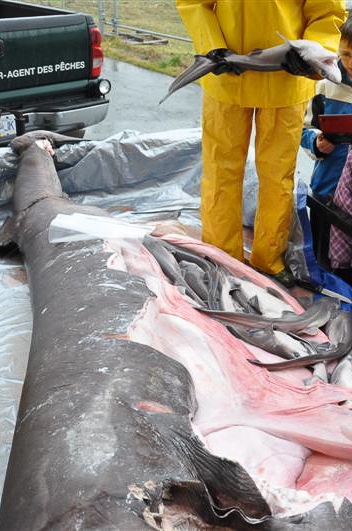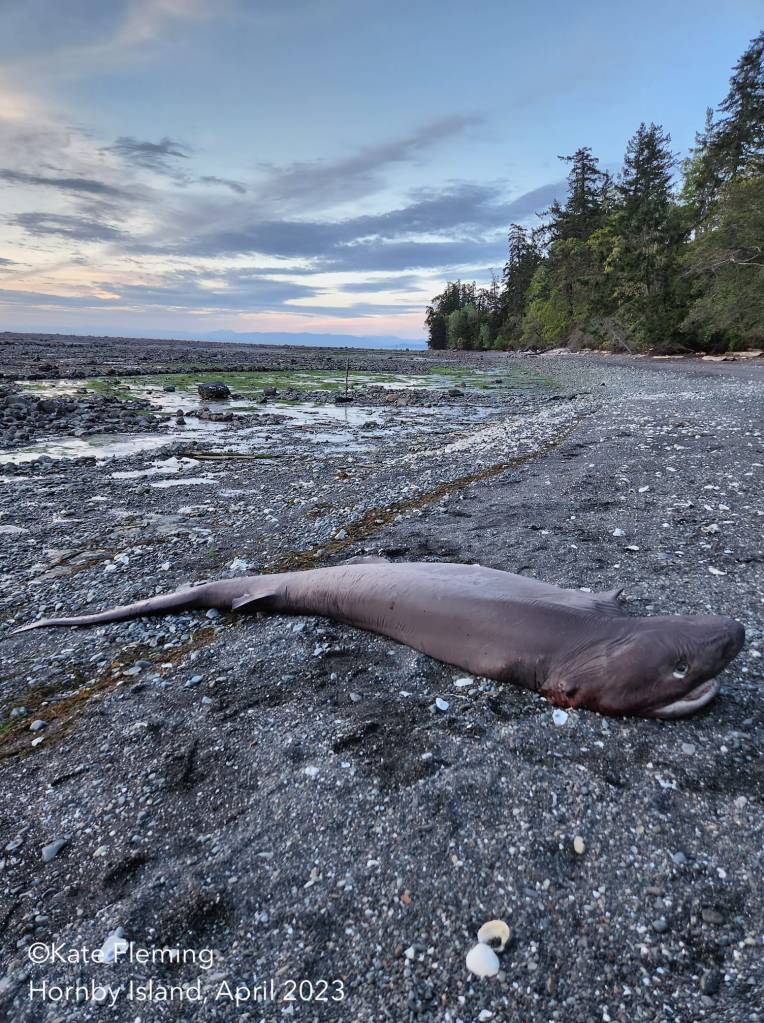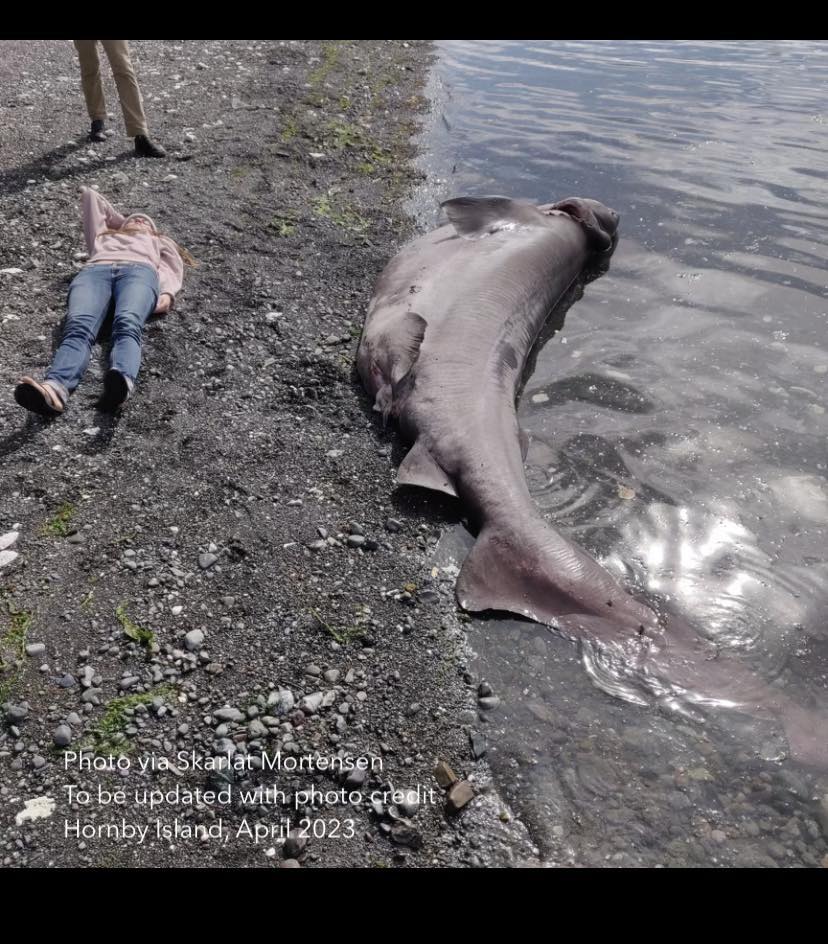Sharks Among Us #2 – The Bluntnose Sixgill Shark
Update May 1, 2023: Original blog is from 2011. I have added photos of additional, known dead Sixgill Sharks at the end of this blog.
And yes, there is a personal connection to this species. While these huge sharks are often in very deep water, I have seen them while diving in at depths of even less than 10 metres. It’s difficult to express the wonder and connection that results from these privileged experiences. It’s somewhat like seeing a living dinosaur. Bluntnose Sixgill Sharks have been perfected by 200 million years of adaptation.
They are not a threat to us. We are a threat to them.
The awe-inspiring images below are of a pregnant female Bluntnose Sixgill Shark (Hexanchu griseus) who was found dead on a beach in Alberni Inlet on low tide in February of 2011. She was necropsied by Department of Fisheries and Oceans staff and there were no obvious indications of how or why she died.
The information below has been generously provided by shark biologist and friend, Romney McPhie. I am sharing in the hopes of increasing respect and understanding for these astounding, huge, deep-dwelling sharks who live off our coast.

This female Sixgill was 4.2 metres and was estimated to weigh 569 kg (1,254 lbs). As a viviparous shark species, she carried her embryos through the entire gestation period which is thought to be over 2 years long (species does not lay eggs / egg cases).
She may have given birth to some prior to her death and still had 28 pups inside her. The young hatch inside the female’s body before entering the ocean (these sharks are “yolk-sac viviparous”).

Sixgill Sharks have been reported to be up to 4.8 metres in length with females being larger than males (males to 3.5 metres). Age of sexual maturity is estimated to be between age 11 to 14 for males and between 18 to 35 years for females. It is believed that life expectancy may be up to 80 years of age.
The Committee on the Status of Endangered Wildlife in Canada (COSEWIC) 2007 assessment report on the Bluntnose Sixgill puts into perspective how rare an opportunity it is to learn about a pregnant Sixgill. It relates that the number of pups carried by females is known from only three previous credible accounts (ranging from 47 to 108 pups which were 61 to 73 cm in size).
The Bluntnose Sixgill Shark is an extremely cryptic species that can dwell at depts up to 2,500 m. So little is known about them and (sigh) they are “near threatened” globally and are a species of “special concern” in Canada.
I have had the incredible privilege of seeing Bluntnose Sixgill Sharks while diving and felt like I was in the presence of greatness. They are living fossils, perfected by 200 million years of adaptation. They are amazingly graceful with large, luminous and intensely green eyes.
They are of absolutely no threat to humans and, like all sharks, have an essential role in marine ecosystems. As top-level predators, sharks strongly shape food webs and the loss of such predators has proven to have profound effects on the number and diversity of other species.

We, however, are a threat to them.
There were historical fisheries and bycatch remains a concern. From 2006 to 2009 there an estimated 1979 Bluntnose Sixgill Sharks were Commercial Hook and Line catch
There is no information on the survival rates from bycatch nor of the accuracy of bycatch reporting. Population size and reproductive rate are not known for this species.
“The primary threats identified for these species are entanglement and bycatch. Other threats identified include pollution, habitat loss or degradation, climate and oceanographic change, and harassment. Historic threats included directed fisheries and entanglement/bycatch. While these populations are migratory throughout the northeast Pacific, it is unknown whether threats occurring outside of Canadian Pacific waters have an impact on these populations.”
Further from the 2022 Fisheries and Oceans Canada Report on the Progress of the Management Plan for Bluntnose Sixgill Sharks:
“The present population size and abundance trends are not known. The only available abundance index (encounter rates with immature Bluntnose Sixgill Sharks at a shallow site in the Strait of Georgia) has decreased significantly (>90%) in the last five years. This index is not likely representative of the overall abundance trend because only immature Bluntnose Sixgill Sharks are encountered and the site is shallow relative to the preferred depth range. The principal known threat to the species is fishing.
The Bluntnose Sixgill Shark has been the focus of at least three directed fisheries in Canadian waters, most recently in the late 1980s and early 1990s. It continues to be caught as bycatch, but survival of released sharks is unknown. Bluntnose Sixgill Sharks observed by divers sometimes show scars from entanglement in fishing gear.
Because of its late age of maturity (18 to 35 years for females), it is likely susceptible to overfishing even at low levels of mortality. Little is known about the abundance and movement patterns of this species elsewhere in the world, so the potential for a rescue effect is unknown.“

Sources for the biology, threats and conservation of Bluntnose Sixgill Sharks:
Fisheries and Oceans Canada. 2022. Report on the Progress of Management Plan Implementation for the Bluntnose Sixgill Shark (Hexanchus griseus) and Tope Shark (Galeorhinus galeus) in Canada for the Period 2012 to 2017. Species at Risk Act Management Plan Report Series. Fisheries and Oceans Canada, Ottawa. iv + 20pp
Fisheries and Oceans Canada, 2012. Management Plan for the Bluntnose Sixgill Shark (Hexanchus griseus) and Tope Shark (Galeorhinus galeus) in Canada [Final]. Species at Risk Act Management Plan Series. Fisheries and Oceans Canada, Ottawa. iv + 37 pp.
COSEWIC (Committee on the Status of Endangered Wildlife in Canada). 2007a. COSEWIC assessment and status report on the Bluntnose Sixgill Shark (Hexanchus griseus) in Canada. COSEWIC, Ottawa, Canada.
NOAA, 2017. Getting to know Sixgill Sharks.


©Ron DeVries.

©Ron DeVries.


14 Responses to “Sharks Among Us #2 – The Bluntnose Sixgill Shark”
if we don’t know anything about them we shouldn’t be fishing them and we should be questioning fishing methods that allow for bi-catch of unknown species…or is it a time of year thing? Like the dragger’s hauling up pregnant lingcods this time of year….or quillbacks spewing eggs as they are hauled in..or or the rec fishermen retaining berried prawns or or or…maybe to much coffee consumed this morning ;-0
Nope Cold Feet – not to much coffee but sheer lucidity. The attitude to by-catch appears to be “we can’t help it” and too it seems to be “oops – their pregnant – who knew” (insert the voices of government regulators here NOT fishers). We KNOW the seasonality of reproduction for species like lingcod and quillbacks!!!! We know as divers but fish observers who report to government know better and this knowledge would inform sustainable fisheries. Keep up the good fight!
Hi Jacqui!
About all those pups inside the six gill…..would she have that many pups at one time? I would have thought only one at a time. Enlighten me please!
Over a matter of days I think Fran but inseminated at the same time so at “full-term” at the same time. Up to a two-year gestation with a very late reproductive age = must have many young at one time for species to survive.
I thought Gord would also be very interested in this find of the pregnant six-gill. I’ll never forget his euphoria at having seen one while diving.
Report said they can have 47 up to 108 pups at a time
Thank you Mike, Adding that information to the blog.
Last week I caught one of these sharks while fishing that we estimated was 12 feet long. Just curious how much the one that was found weighed.
Hello Wes,
I don’t believe they had an opportunity to weigh this female. The largest record I was able to find for this species is 590 kg.
It would be valuable if you could share where you caught the six gill; at what depth; what fishing method, etc.
Greatly appreciate it.
We were fishing out of Virginia Beach VA around the Norfolk Canyon. It is about 65 miles off the coast we were in about 600 feet of water. I was fishing with Ken Neill who has been been deep drop fishing that are for about 7 years I think. I have been fishing with him a couple years now. Just about every trip we have had an encounter with something we could not get up and would break a rod or line. I lost two last year and the day I got the six gill to the surface, I had something on for about 30 minutes before loosing it. I was using a rig I made out of 300 pound mono leader with one light on it, large spinner blades and cut fish for bait. Ken takes lots of pictures if you want any,
Thank you Wes. I came across this posting on a fishing forum about someone catching a bluntnose six gill in VA. Maybe of interest? See link.
I am also interested (with much respect for the passion of recreational fishers), would it be typical to keep a 6 gill shark or is it about the fight and then the shark would be released?
http://www.tidalfish.com/forums/showthread.php/299657-Sea-Monster?s=e5c8c49ffe7795f73789c591b80aa4c3
Yeah, that was us in the Sea Monster report. We let the shark go. We were actually fishing for grouper. We catch and eat plenty of fish but I have no desire to kill something like that. I just enjoyed catching it except for the last 15 minutes when I thought it was going to win over me and my back.
That is Wes’ fish. Not a targetted catch at all. We were fishing for golden tilefish and snowy grouper. The shark was released and seemed to be fine, swam away strong.
Hello Wes and Ken,
Thank you so much for your responses. I can only imagine what it would be like to try to get a six gill to the surface! As a diver, I’ve been mindblown to see how, what first appears to be a slow moving giant, can power away.
With so little known about these species, it is great to know that (thanks to your ethics) this one continued on to live its mysterious life at depth.
Awe-inspiring photos!
Jackie
Awe-inspiring photos.
Here is the copy of my email to Wes (and his sore back)!
Hello Wes and Ken,
Thank you so much for your responses. I can only imagine what it would be like to try to get a six gill to the surface! As a diver, I’ve been mindblown to see how, what first appears to be a slow moving giant, can power away.
With so little known about these species, it is great to know that (thanks to your ethics) this one continued on to live its mysterious life at depth.
Awe-inspiring photos!
Jackie